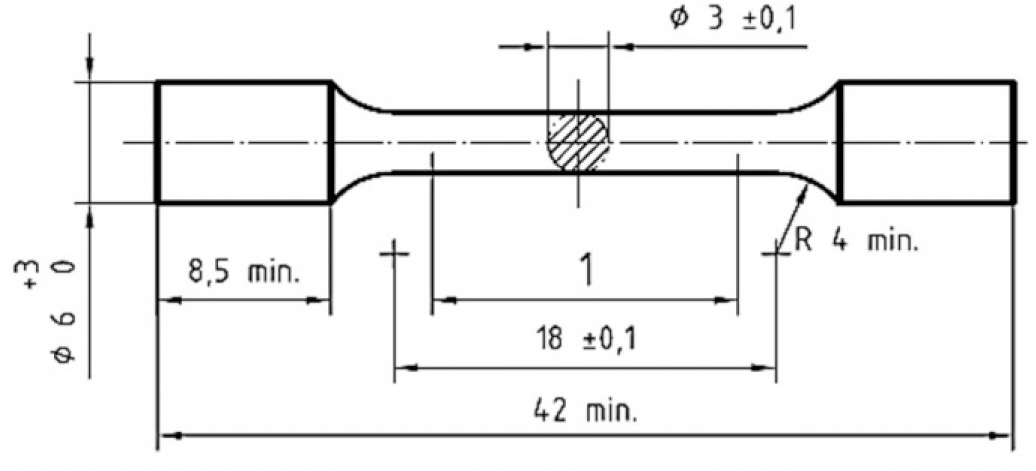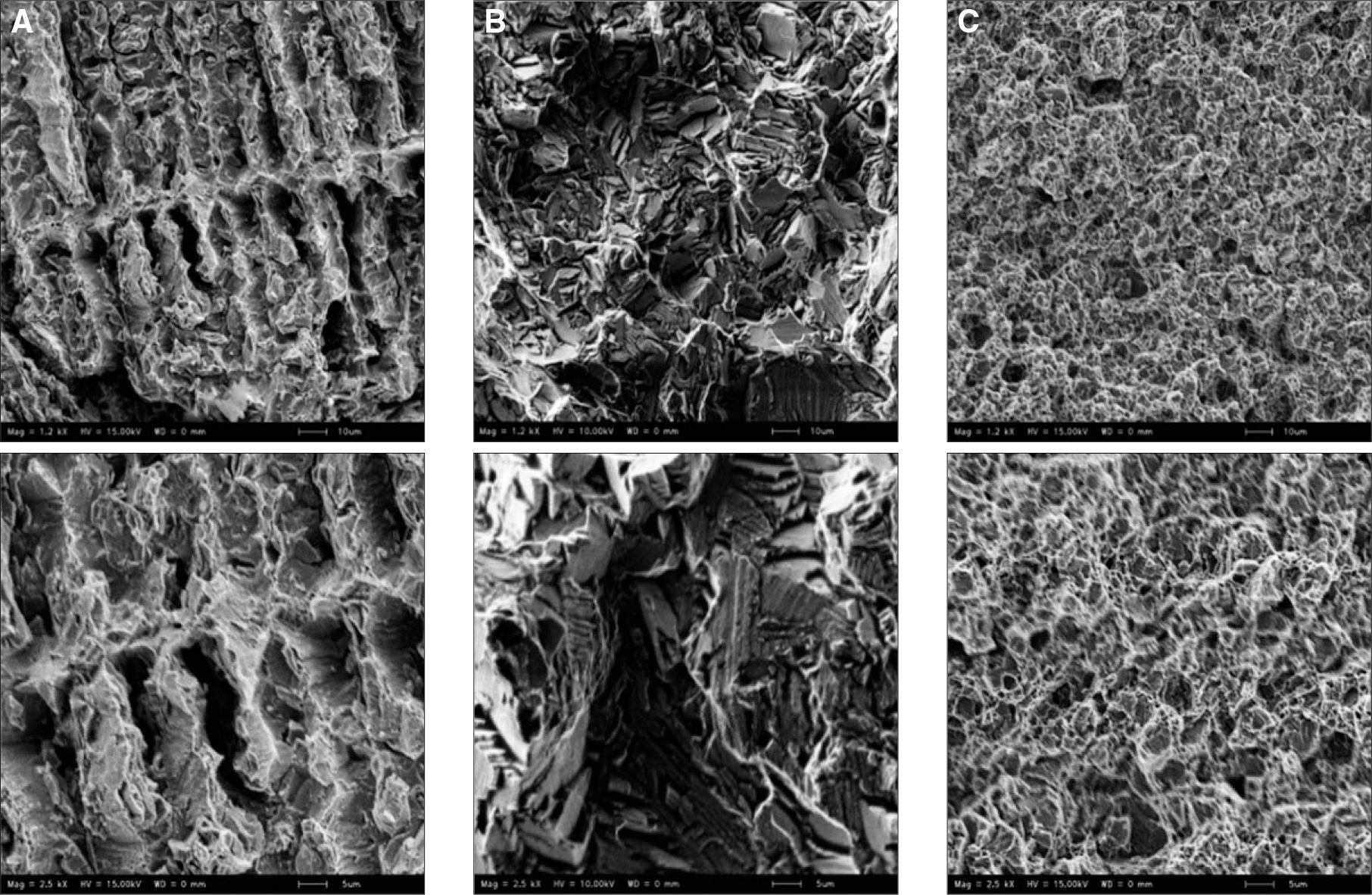J Korean Acad Prosthodont.
2014 Apr;52(2):67-73. 10.4047/jkap.2014.52.2.67.
Comparison of the mechanical properties and microstructures of fractured surface for Co-Cr alloy fabricated by conventional cast, 3-D printing laser-sintered and CAD/CAM milled techniques
- Affiliations
-
- 1Department of Prosthodontics, School of Dentistry, Seoul National University, Seoul, Republic of Korea. young21c@snu.ac.kr
- 2Department of Dental Biomaterials Science, School of Dentistry, Seoul National University, Seoul, Republic of Korea.
- 3US Army Carius Dental Clinic, Dentac-Korea, 618th Dental Command, Seoul, Republic of Korea.
- KMID: 2000131
- DOI: http://doi.org/10.4047/jkap.2014.52.2.67
Abstract
- PURPOSE
The purpose of present study is to compare mechanical properties and microstructural characteristics of fractured surface for cast, 3-D printing laser sintered and CAD/CAM milled cobalt-chromium (Co-Cr) alloy specimens and to investigate whether laser sintered technique is adequate for dental applications.
MATERIALS AND METHODS
Thirty six flat disc shape Co-Cr alloy specimens were fabricated for surface hardness test and divided into three groups according to the manufacturing methods; 12 specimens for casting (n=12), 12 specimens for laser sintered technology (n=12) and 12 specimens for milled technology (n=12). Twelve dumbbell shape specimens for each group were also fabricated for a tensile test. Statistical comparisons of the mechanical properties for the alloys were performed by Kruskal-Wallis test followed by Mann-Whitney and Bonferroni test. The microstructural characteristics of fractured surfaces were examined using SEM.
RESULTS
There were significant differences in the mean Vickers hardness values between all groups and the cast specimen showed the highest (455.88 Hv) while the CAD/CAM milled specimen showed the lowest (243.40 Hv). Significant differences were found among the three groups for ultimate tensile strength, 0.2% yield stress, elongation, and elastic modulus. The highest ultimate tensile strength value (1442.94 MPa) was shown in the milled group and the highest 0.2% yield strength (1136.15 MPa) was shown in the laser sintered group.
CONCLUSION
Different manufacturing methods influence the mechanical properties and microstructure of the fractured surfaces in Co-Cr alloys. The cast Co-Cr alloy specimens showed the highest Vickers hardness, and the CAD/CAM milled specimens revealed the highest tensile strength value. All alloys represent adequate mechanical properties satisfying the ISO standards of dental alloy.
MeSH Terms
Figure
Reference
-
1.Wataha JC. Alloys for prosthodontic restorations. J Prosthet Dent. 2002. 87:351–63.
Article2.Akova T., Ucar Y., Tukay A., Balkaya MC., Brantley WA. Comparison of the bond strength of laser-sintered and cast base metal dental alloys to porcelain. Dent Mater. 2008. 24:1400–4.
Article3.de Vasconcellos LG., Buso L., Lombardo GH., Souza RO., Nogueira L Jr., Bottino MA., Ozcan M. Opaque layer firing temperature and aging effect on the flexural strength of ceramic fused to cobalt-chromium alloy. J Prosthodont. 2010. 19:471–7.
Article4.Viennot S., Dalard F., Lissac M., Grosgogeat B. Corrosion resistance of cobalt-chromium and palladium-silver alloys used in fixed prosthetic restorations. Eur J Oral Sci. 2005. 113:90–5.
Article5.Wu Y., Moser JB., Jameson LM., Malone WF. The effect of oxidation heat treatment of porcelain bond strength in selected base metal alloys. J Prosthet Dent. 1991. 66:439–44.6.Takaichi A., Suyalatu ., Nakamoto T., Joko N., Nomura N., Tsutsumi Y., Migita S., Doi H., Kurosu S., Chiba A., Wakabayashi N., Igarashi Y., Hanawa T. Microstructures and mechanical properties of Co-29Cr-6Mo alloy fabricated by selective laser melting process for dental applications. J Mech Behav Biomed Mater. 2013. 21:67–76.
Article7.Fasbinder DJ. Clinical performance of chairside CAD/CAM restorations. J Am Dent Assoc. 2006. 137:22S–31S.
Article8.Suleiman SH., Vult von Steyern P. Fracture strength of porcelain fused to metal crowns made of cast, milled or laser-sintered cobalt-chromium. Acta Odontol Scand. 2013. 71:1280–9.9.Quante K., Ludwig K., Kern M. Marginal and internal fit of metal-ceramic crowns fabricated with a new laser melting technology. Dent Mater. 2008. 24:1311–5.
Article10.Xin XZ., Chen J., Xiang N., Wei B. Surface properties and corrosion behavior of Co-Cr alloy fabricated with selective laser melting technique. Cell Biochem Biophys. 2013. 67:983–90.
Article11.ISO Standard 9693. Metal-ceramic dental restorative systems. International Organization for Standardization;Geneva, Switzerland: 1999E.12.Qiu J., Yu WQ., Zhang FQ., Smales RJ., Zhang YL., Lu CH. Corrosion behaviour and surface analysis of a Co-Cr and two Ni-Cr dental alloys before and after simulated porcelain firing.13.Wu L., Zhu H., Gai X., Wang Y. Evaluation of the mechanical properties and porcelain bond strength of cobalt-chromium dental alloy fabricated by selective laser melting. J Prosthet Dent. 2014. 111:51–5.
Article14.Ucar Y., Brantley WA., Johnston WM., Dasgupta T. Mechanical properties, fracture surface characterization, and microstructural analysis of six noble dental casting alloys. J Prosthet Dent. 2011. 105:394–402.
Article15.Kruth JP., Froyen L., Vaerenbergh JV., Mercelis P., Rombouts M., Lauwers B. Selective laser melting of iron-based powder. J Mater Process Technol. 2004. 149:616–22.
Article16.Shiomi M. Osakada K, Nakamura K, Yamashita T, Abe F. Residual stress within metallic model made by selective laser melting process. CIRP Annals - Manuf Technol. 2004. 53:195–8.17.Kellerhoff RK., Fischer J. In vitro fracture strength and thermal shock resistance of metal-ceramic crowns with cast and machined AuTi frameworks. J Prosthet Dent. 2007. 97:209–15.
Article
- Full Text Links
- Actions
-
Cited
- CITED
-
- Close
- Share
- Similar articles
-
- Comparison of Mechanical Properties of Milled and Casted Cobalt-Chromium Alloys Using Three-point Bending Test
- Dental Co-Cr alloys fabricated by selective laser melting: A review article
- Comparison of fracture strength, surface hardness, and color stain of conventionally fabricated, 3D printed, and CAD-CAM milled interim prosthodontic materials after thermocycling
- Influence of finish line design on the marginal fit of nonprecious metal alloy coping fabricated by 3D printing, milling and casting using CAD-CAM
- Influence of surface treatments and repair materials on the shear bond strength of CAD/CAM provisional restorations



